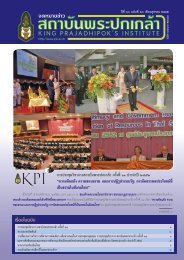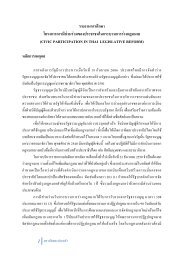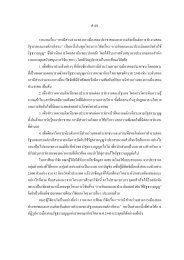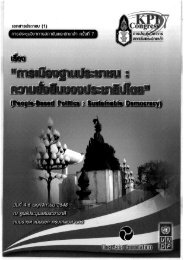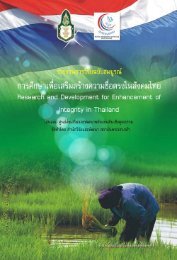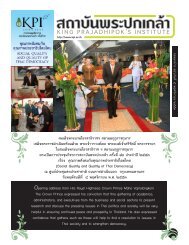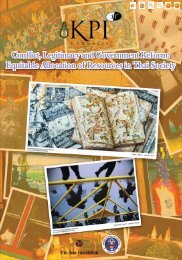SUFFiciENcy EcONOMy ANd GRASSROOtS DEvElOPMENt
SUFFiciENcy EcONOMy ANd GRASSROOtS DEvElOPMENt
SUFFiciENcy EcONOMy ANd GRASSROOtS DEvElOPMENt
You also want an ePaper? Increase the reach of your titles
YUMPU automatically turns print PDFs into web optimized ePapers that Google loves.
282<br />
The Meaning of Sufficiency Economy <br />
International Conference<br />
purchasing power sufficient to procure a collection of basic items of consumption<br />
deemed to constitute ‘basic’ or ‘minimum’ collection, but also elementary education<br />
for all children up to 14 years of age; minimum public health facilities integrated<br />
with family planning and nutrition for children; protected water supply; amenities<br />
for landless labour and slum improvement in larger towns; and rural roads and rural<br />
electrification.<br />
The idea of direct, targeted poverty alleviation programmes quickly took root<br />
and gained widespread acceptance across the entire political spectrum.<br />
Governments, at the centre and in the states, have since viewed with each other in<br />
increasing allocations and devising new schemes (or the same schemes under<br />
different names) under this rubric. Along with the number and variety of schemes,<br />
financial allocations have also increased progressively. Motivations were of course<br />
not as high minded as the slogans made out. In this juncture, the evolution of<br />
microfinance plays a significant role. <br />
Microfinance, which includes micro savings, is gradually emerging as one of<br />
the most effective strategies to alleviate poverty. It can effectively generate<br />
employment and sustain the income of the households by giving them opportunities<br />
of work. Although micro credit institutions are effective weapons in the war against<br />
rural poverty they alone cannot neutralise non physical symptoms of poverty which<br />
deprive the poor of a full social existence. <br />
Since 1970s, developing countries, including India, have increasingly focused<br />
on micro credit to facilitate the access of poor households to financial services like<br />
credit, savings, insurance etc. As the rural population in India, forming about twothird<br />
of her total population is still dependent on agriculture, there is a crying need<br />
for timely and adequate availability of funds for agricultural and rural finance is a<br />
must for improving the lot and income of the poor.<br />
<br />
Some Facts Related to Demand-Supply of<br />
Micro-Finance<br />
There is a vast unmet gap in the provisions of financial services to the poor. A<br />
very little segment of the poor people is being served by the formal financial system<br />
for micro-credit. Majority of the poor population depends on informal financial<br />
system for their credit needs. Let us look at some facts.<br />
According to the World Development Report (2000), 1.8 billion people<br />
live in extreme poverty, subsisting on less than US $ 1 a day and almost half of the<br />
world population (2.8 billion) live on less than US $ 2 a day. South Asia is the home<br />
to half of the world’s poor families. In African countries, women account for more<br />
than 60 per cent of the agriculture labour force and contribute up to the 80 per cent<br />
of the total food production, yet receive less than 10 per cent of the credit provided<br />
to small farmers.



